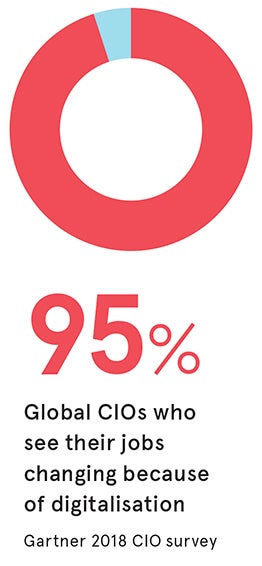Digital disruption touches all aspects of a company, but perhaps none more so than the IT department. As the rules for conducting business change, the demands on the chief information officer change too, the job evolving with the current wave of technological innovation.
According to a 2018 report from Gartner, 84 per cent of CIOs at top-performing organisations have responsibility for areas of the business outside traditional IT, the most common being innovation and transformation. “The CIO’s role is transforming from delivery executive to business executive,” the report says.
The report, Mastering the New Business Executive Job of the CIO, adds: “In step with this is a shift in CIO success criteria, from IT delivery objectives to more business-based measures”.
Digital execution requires new approaches and unprecedented collaboration between IT and business; ultimately, digital transformation is where the IT function evolves from a service provider to a business driver and, importantly, becomes accepted as such by the wider business.
So what is the challenge for today’s CIO, now tasked with driving digital transformation? It is less to do with the technology, critical though that remains, and more about leading the change required among people. Many employees are resistant to change – that’s just human nature – but true digital transformation needs internal buy-in at all levels.
This is not a matter solely for the IT department; to be successful, it needs a company-wide cultural shift. This challenge could be particularly prevalent in the public sector, where employees are often not afforded the time or resources to transform their ways of working; but it can be equally challenging in the private sector for a CIO to direct and manage a transformation in mindset. It is those CIOs that understand how advances in digital technology allow organisations to be better than the competition who will enable their organisation to save on the bottom line, and reap the rewards on the top line.

IT and CIOs need to speak the language of business, talking about the outcome that matters: satisfying the customer’s needs. Ultimately any organisation exists to be profitable while fulfilling a demand; it is the customer journey that drives the business, not the technology by which that journey can be made.
Yet this may not prove the CIO’s biggest challenge. Yes, IT needs to speak the language of business and help its working practices evolve; but it is at board level, among the non-IT executives, that real change must take place. Too many boards fail to understand that technology is the only thing that will advance their business, a failure that hamstrings IT departments. There are bright spots of good practice, with huge investments in areas that wouldn’t have been considered five years ago, but such bright spots are few and far between. The sooner boards understand and endorse the true value of IT, the sooner digitalisation can flourish.
So what can the CIO do to drive this understanding? It is a question of focusing on the people. Conversations about digital transformation are too often focused on the technology, but transformation has to filter down from the top: starting with the executives who define the strategy, moving down to the teams who drive execution and finishing with the staff whose face-to-face work with customers can bring new insights that should be passed back up the organisation. Digitalisation necessitates a shift in people, remuneration and working practices.
CDW is clearly seeing the shift in IT from a traditional, internal service provider, along a transformation line that moves from broker of services, to broker of ideas and innovation, to thought leader. It is a shift that puts new pressures on organisations to identify the correct talent requirements for the future; no easy task, given that many of the jobs of the future have yet to be created. Businesses are getting younger (the average age of a Fortune 500 company in 2017 was less than 20 years according to a Credit Suisse study), while technology is changing faster than ever. CIOs need to look at the skills gap in existing talent, calculate how a bridge to tomorrow’s world can be built, and determine today’s recruitment needs.
Digital transformation, by its very nature, cannot be delivered by any one department. It requires a change in how commercial, public and reseller organisations work. There is a need to move to multi-discipline, interdepartmental and inter-agency engagements, changing working practices to adopt iterative, results-driven and agile ways of working.
That change may also affect how staff are compensated. In a world where innovation and ideas are paramount, employees that generate creative practices or products should be rewarded for their ideas.
The level of digital disruption faced by the corporate world is huge. CDW as a service provider faces the same challenges as its customers, and has to meet its customers’ needs by offering outcomes-driven solutions, communicated in the language business will understand.
IT has to understand that if it cannot relate its knowledge to the business, its relevance will decline; today’s CIO needs to be able to participate when the leadership creates a knowledge-sharing culture. Change is the one constant for today’s organisation, but by focusing on the why as much as the how, a CIO can demonstrate the continued importance of IT to a successful business.
For help solving complexity with people who get IT, visit www.uk.cdw.com
Lee Hendra is solutions sales director for CDW UK. He has extensive knowledge of the challenges of business transformation through working closely with clients – including some of the UK’s most digital businesses – on their data centre solutions.
READ MORE: C-Suite: who they are, what they do and why they matter

